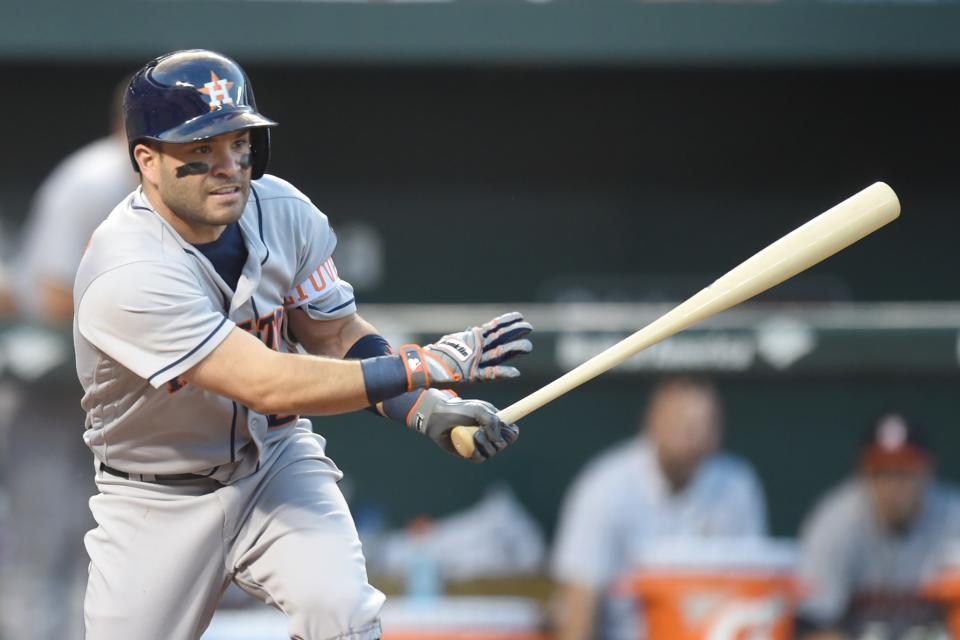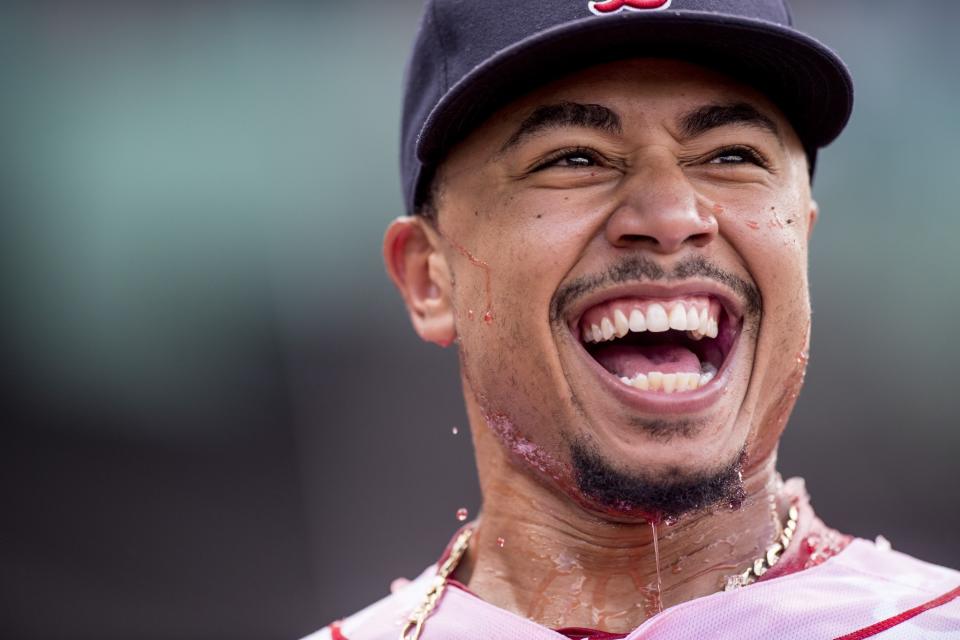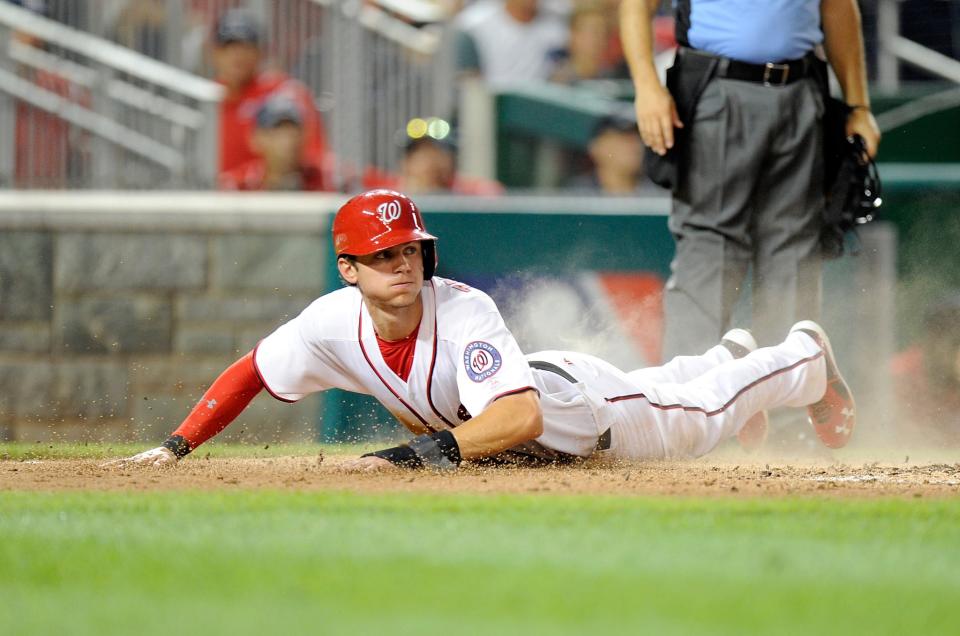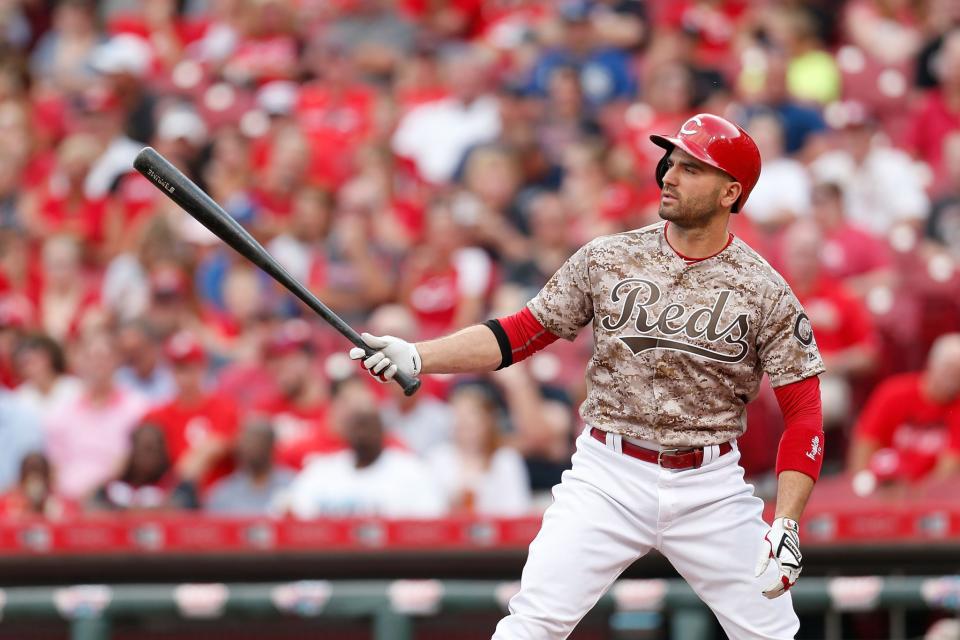The four contenders in AL’s cutthroat MVP race
Go to Rio for a month and look at what happens. Babe Ruth is resurrected, and he’s hitting right-handed and playing catcher. The Giants, the best team in baseball at the All-Star break, are literally the worst since. Ian Kennedy’s ERA in August can be spelled out in binary code. Baseball does this. Every month is its own little season of the absurd, the impossible, the unrepeatable, the glorious.
Only two things are the same.

a) Clayton Kershaw, on the disabled list for two months, still has the best numbers of any pitcher in baseball. (This is patently absurd, by the way.)
b) The American League MVP race is a completely jumbled mess.
And, as an AL MVP voter this season, I love it. A contentious awards race only adds to the intrigue of a September that currently has 10 of 15 AL teams and 8 of 15 NL teams with legitimate playoff aspirations. That’s a 60 percent meaningful-September rate. Not bad.
The MVP race is even better. At the risk of unleashing the baseball Breitbarts by having the temerity to put …
1. Mike Trout first in this conversation, well, consider that Pandora’s box open. Now, this does not mean Trout is on top of my ballot at the moment. Honestly, I don’t even want to engage in one of those if-the-season-ended-today hypotheticals because more than 30 games remain, and extraordinary things happen over those 30 games. Trout is here mainly because I came across something during research that dumbfounded me.
Is this good? pic.twitter.com/QjHC1Dsmcn
— Jeff Passan (@JeffPassan) August 29, 2016
Yes, that is the leaderboard for the last five seasons of Wins Above Replacement as judged by Baseball-Reference.com. Trout leads FanGraphs’ WAR during those five years, too. I was curious: When we the last time a player led his league five straight years?
Prime Albert Pujols? Nope. Four straight, from 2006-09. Surely Barry Bonds? Nuh-uh. Just four, 2001-04. To find the next with four straight, go back more than half a century, to Willie Mays, from 1962-65. And before that, Mickey Mantle, ’55 to ’58. Generation after generation, no one managed to lead his league in WAR for half a decade.
The last player was Babe Ruth, from 1926-31. Only Walter Johnson, from 1912-16, did it before him. Trout this year could accomplish something that hasn’t been seen in 85 years. And history says … well, we’ll save that little nugget for later, because it encapsulates everything about Trout’s first five years in the big leagues, and for now we need to look at the rest of the candidates. So, without further ado …
2. Jose Altuve can bat leadoff, which he has done with striking aplomb this season for the Houston Astros. Currently, Altuve is leading the AL in batting average (.355) and ranks second in on-base percentage (.415), third in slugging (.565), third in stolen bases (26) and second in strikeout rate (10.1%). He is the odds-on favorite, at least according to handicappers.

Trout is, more or less, Altuve’s equal. His .312 batting average is sixth, his .431 OBP first, his .546 slugging percentage eighth, his 21 stolen bases fourth. Trout’s walk rate leads the AL. Their OPS is almost identical, their OPS+ about the same, and Trout is generally considered the superior baserunner and plays a harder position. This is why he grades out higher in WAR.
What’s working in Altuve’s favor is his team, and here’s the thing: The Astros’ fortunes aren’t looking great at the moment. Baseball Prospectus pegs Houston’s playoff chances at about 23 percent. MLB.com has them at 22 percent. FanGraphs says it’s less than 20 percent. Which means it’s quite likely that Jose Altuve will be spending his October in the same place as Mike Trout: home.
So for those MVP voters who only consider players in the playoffs – a group that hopefully gets lesser and lesser by the year – perhaps …
3. Mookie Betts is the candidate of choice. Because recent history says the Red Sox – currently in second in the AL East and atop the wild-card standings – are making the playoffs. Boston is on pace to score 874 runs. This decade, 10 teams have scored 800-plus runs in a season. Eight have made the postseason.
The only two that didn’t were Boston in 2010 and 2011. This year’s Red Sox have a significantly better pitching staff. Boston’s team ERA this year is 11 percent better than league average when adjusted for park, which is third in the AL. The 2010 team’s ERA+ was sixth and 2011’s seventh. An offense like this, plus representative pitching, equals playoffs.

For Betts’ candidacy, that’s a good thing. The issue with it: Not just the fact he’s not even the best offensive player on his team – hello, David Ortiz – but he’s not anywhere in Trout or Altuve’s echelon offensively. As great of a hitter as Betts is (really great) and as great of a baserunner as he is (really great) and as good of a right fielder as he is (quite good), he makes more outs than Altuve and Trout. Like, a lot more.
Betts has made the fourth most outs in all of baseball this season. Now, part of that is a function of playing in a lineup that scores as many runs as the Red Sox’s. Betts gets more plate appearances. Still, his .360 on-base percentage is glaring next to Altuve’s and Trout’s that start with a 4. Not to mention …
4. Josh Donaldson, the seemingly forgotten entrant in this race who, oh, by the way, has a higher OPS than any of the three aforementioned, more home runs and, yes, an OBP that starts with a 4, too.
Donaldson is the reigning AL MVP as well, and voters aren’t quite yet fatigued with his excellence like they seem to be Trout’s. And the way the Toronto Blue Jays are playing – Donaldson hitting tanks, Russell Martin re-emerging as a force, trade-deadline gets Jason Grilli and Joaquin Benoit combining for more than 20 scoreless innings in August – the playoffs seem almost foregone for them just the same.
So, yes, it’s a four-way race, and a pretty delightful one at that. It might have been five if …
5. Gary Sanchez hadn’t spent the first four months of the season at Triple-A, where, it should be remembered, he hit .282/.339/.468, which is fine for a 23-year-old but looks downright pedestrian compared to this demogorgon behind the plate for the Yankees these days.
Since joining the Yankees full-time after the trade deadline, Sanchez has played in 21 games. He has hit 11 home runs, driven in 21 runs, walked 10 times, batted .421, reached base at a .488 clip and slugged .947. Before Sanchez, only 49 times in history had a rookie catcher hit 11 home runs in a season, let alone a month. One of those who needed the full year was the Yankees catcher in 1947. It took Yogi Berra 83 games.
So, yeah, Gary Sanchez is ridiculous, and …
6. Trea Turner has him and only him to blame for blotting away what would’ve been the standout rookie August in all of baseball otherwise. The 23-year-old shortstop-turned-center fielder is in the midst of a crazy binge of six consecutive games with multiple hits, which has helped push his month-long total to a National League-leading 40.

With Turner leading off, suddenly the Nationals can flash a lineup with him, Bryce Harper (.348/.439/.565 in August), Daniel Murphy, Anthony Rendon (.345/.412/.586 in August), Wilson Ramos and the still-dangerous Jayson Werth. Turner adds the sort of depth that only the Cubs can match among NL contenders, and Washington’s .434 team slugging percentage is actually identical to Chicago’s.
It’s getting on base that’s the Nationals’ comparative weakness – the Cubs are 16 points better – though with Turner in the lineup full-time in August, the Nationals actually have gotten on base more than Chicago, 35.1 percent of the time to 34.9 percent. Which is about as surprising as …
7. DJ LeMahieu leading the major leagues in on-base percentage since August began. Two years ago, LeMahieu was a career .314 OBP guy. Now he’s a hitting machine whose .344 batting average tops the NL and whose spray chart would make you think he’s left-handed.
Source: FanGraphs
LeMahieu is a righty, though, and this is just another convention he defies in a career full of them. At 6-foot-4, he isn’t too tall to play second base. Just because he’s in Colorado doesn’t mean he needs to hit for power. It’s cool for a guy to look to go to the opposite field. And it is possible, even at 28 years old, to drastically improve your plate discipline.
His walk rate is 10.7 percent, nearly 4 percentage points higher than his career average. His strikeout rate is 12.6 percent, about 4 percentage points lower. And in August, LeMahieu is hitting .469/.561/.679 with 16 walks and six strikeouts. The fact that …
8. Joey Votto’s entire post-All-Star break numbers almost match those – .444/.541/.707 – is incredible, though it’s not entirely out of the ordinary for Votto seeing as his first- and second-half splits last year were similarly skewed.

In 2015, Votto hit .277/.392/.484 in the first half and .362/.535/.617 in the second. His first-half numbers this season were a bit less – .252/.386/.446 – but what Votto has done over the last six weeks shows that even on an awful Cincinnati Reds team, he is one of the few hitters worth the price of admission.
The best part: Nearly 550 plate appearances into this season, Votto still hasn’t popped out on the infield. In his 5,294-plate appearance career, he has popped out 15 times. In 528 plate appearances this season, his former teammate Todd Frazier has popped out 32 times.
Long story short: Joey Votto, still awesome. Still not the best player in his draft class, though. The king of 2002, per Baseball Reference WAR, is Zack Greinke. And the man between him and Votto is …
9. Cole Hamels, who very quietly has emerged as the American League Cy Young favorite. With the reliever-for-Cy Young campaign mercifully laid to rest, we now can search for the real answer as to who the best pitcher in the AL is, a question almost as rife with peril as the MVP, though for different reasons.
Zach Britton’s fledgling candidacy only exists because the pool of starters in the AL – hell, all throughout baseball – is a big bowl of meh. Hamels, for now, seems to have the secret sauce: good ERA (AL-leading 2.67), lots of innings (168⅔, up there with league leaders on a per-start basis), adequate strikeouts (nearly one an inning). His 14-4 record certainly won’t hurt him, though Cy Young voters proved long ago that record is no longer the deciding factor it once was.
Chris Sale and Corey Kluber seem to have the inside track on Hamels, and a host of others, from Jose Quintana to Michael Fulmer to Danny Duffy to Justin Verlander to Rick Porcello to Aaron Sanchez to J.A. Happ, should get votes. American League baseball in September is primed to be a lot of fun, even if …
10. Mike Trout is playing out his month for a last-place team with a barren farm system whose greatest hope for contention in the immediate future is to trade the guy who might lead the league in WAR the first five full years of his career. How depressing.
Even worse is that unless he blows Altuve and Betts and Donaldson away with his September, Trout is probably going to be a non-factor in MVP voting. And that’s where history dovetails with present. During the six straight years Ruth led the AL in WAR, here’s how many MVPs he won: zero. Johnson won it only once.
Now, the MVP was different back then. In Johnson’s case, it was called the Chalmers Award, and it was discontinued during his run. And with Ruth, he had won the MLB-awarded MVP in 1923 and thus was disqualified from winning it again during almost the entirety of his stretch.
No such limitations stand in Trout’s way, and the chances of him leading the AL in WAR – a flawed metric, no doubt, but the best measure we have for comparing current and past players – for five seasons and winning just one MVP during that stretch is strong. His cases over Miguel Cabrera in 2012 and ’13 are obvious. Him vs. Donaldson last year was a coin flip. And this season? Well, there’s a month left to play and three men primed to steal the award from him.
And wrong though it may be, here’s the undeniable truth: MVP candidates are made in April through August. MVP winners are made in September.


